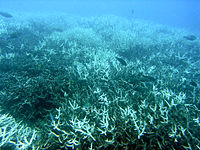
Photo from wikipedia
Extreme temperatures are among the most important stressors limiting plant growth and development. Results indicate that light substantially influences the acclimation processes to both low and high temperatures, and it… Click to show full abstract
Extreme temperatures are among the most important stressors limiting plant growth and development. Results indicate that light substantially influences the acclimation processes to both low and high temperatures, and it may affect the level of stress injury. The interaction between light and temperature in the regulation of stress acclimation mechanisms is complex, and both light intensity and spectral composition play an important role. Higher light intensities may lead to overexcitation of the photosynthetic electron transport chain; while different wavelengths may act through different photoreceptors. These may induce various stress signalling processes, leading to regulation of stomatal movement, antioxidant and osmoregulation capacities, hormonal actions, and other stress-related pathways. In recent years, we have significantly expanded our knowledge in both light and temperature sensing and signalling. The present review provides a synthesis of results for understanding how light influences the acclimation of plants to extreme low or high temperatures, including the sensing mechanisms and molecular crosstalk processes.
Journal Title: International Journal of Molecular Sciences
Year Published: 2021
Link to full text (if available)
Share on Social Media: Sign Up to like & get
recommendations!